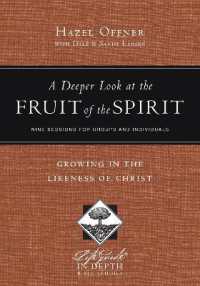- ホーム
- > 洋書
- > 英文書
- > Architecture
Full Description
This volume is the first sustained critical analysis of Chris Dyson Architects' philosophy, approach and body of work, focusing on their particular expertise in being sensitive to a sense of place, history and heritage.
Since Chris Dyson set up his own practice in 2004, he has gained a reputation as one of the foremost historic conservation architects, poetically adapting listed buildings for the 21st century. Yet the vigour and originality he brings to his work is far from a conventional conservation approach. Dyson's is an architecture seemingly with no rules, yet at the same time marked by a recurring interest in the interactions between people and city, culture and community.
Dyson's work is indelibly associated with Spitalfields, having lived and worked there since 1990, and it's a place that provides a fitting metaphor for his architecture. Over its history Spitalfields has been subject to recurring waves of new people and cultures, which has created somewhere defined by its rich cultural and material layers. And so with Dyson's architecture, in which, even with new-build projects, there's an overriding sense of different elements - be they material, temporal or cultural - coming together into coherent wholes. Dyson's is that rare thing: architecture that feels old and new at the same time.
Contents
Foreword, Owen Hopkins. General Introduction. Residential; Dyson House, Spitalfields; Faulkner
Residence, Spitalfields; Gasworks, Cotswolds; Clerkenwell Cooperage; Hampton Lodge, Sussex; Wapping Pierhead House. Mixed Use; Albion Works, Hackney; The Queens
Head/Dyson Offices & MTE, Spitalfields; The Sekforde, Clerkenwell; Chanarin
Residence & Studio, Spitalfields; Timothy Everest Store, Shoreditch; Architect's Retreat and Studio, Suffolk. Culture and Community; Maison
Colbert, London; Eleven Spitalfields Gallery & Offices; Crystal Palace Café & Community Space; Bookshop
Confer & Karnak, Spitalfields








